Comprehensive Report on Resource and Talent Planning at Keller Group
VerifiedAdded on 2020/06/06
|13
|4081
|81
Report
AI Summary
This report provides a comprehensive analysis of resource and talent planning within the Keller Group, a global geotechnical solutions specialist. It begins by defining resource and talent planning as a managerial function focused on optimal allocation of human and material resources to achieve beneficial outcomes, emphasizing the importance of aligning employee skills with tasks. The report then delves into workforce planning, examining current labor market trends such as the return of "boomerang" candidates, office rearrangements to attract talent, and the growth of freelance and part-time jobs. It also explores the legal requirements impacting workforce planning, including the Civil Rights Act of 1866, the Equal Pay Act of 1963, and the Age Discrimination in Employment Act of 1967. The report further discusses job descriptions, job specifications, and the stages of the HR life cycle, providing insights into effective recruitment, selection processes, and employee management strategies. Finally, it evaluates the stages of the HR life cycle within the Keller Group and integrates these stages within the company's overall strategic objectives. This report aims to provide valuable insights into the critical aspects of resource and talent planning within the Keller Group, with a focus on workforce trends, legal requirements, and the HR life cycle.
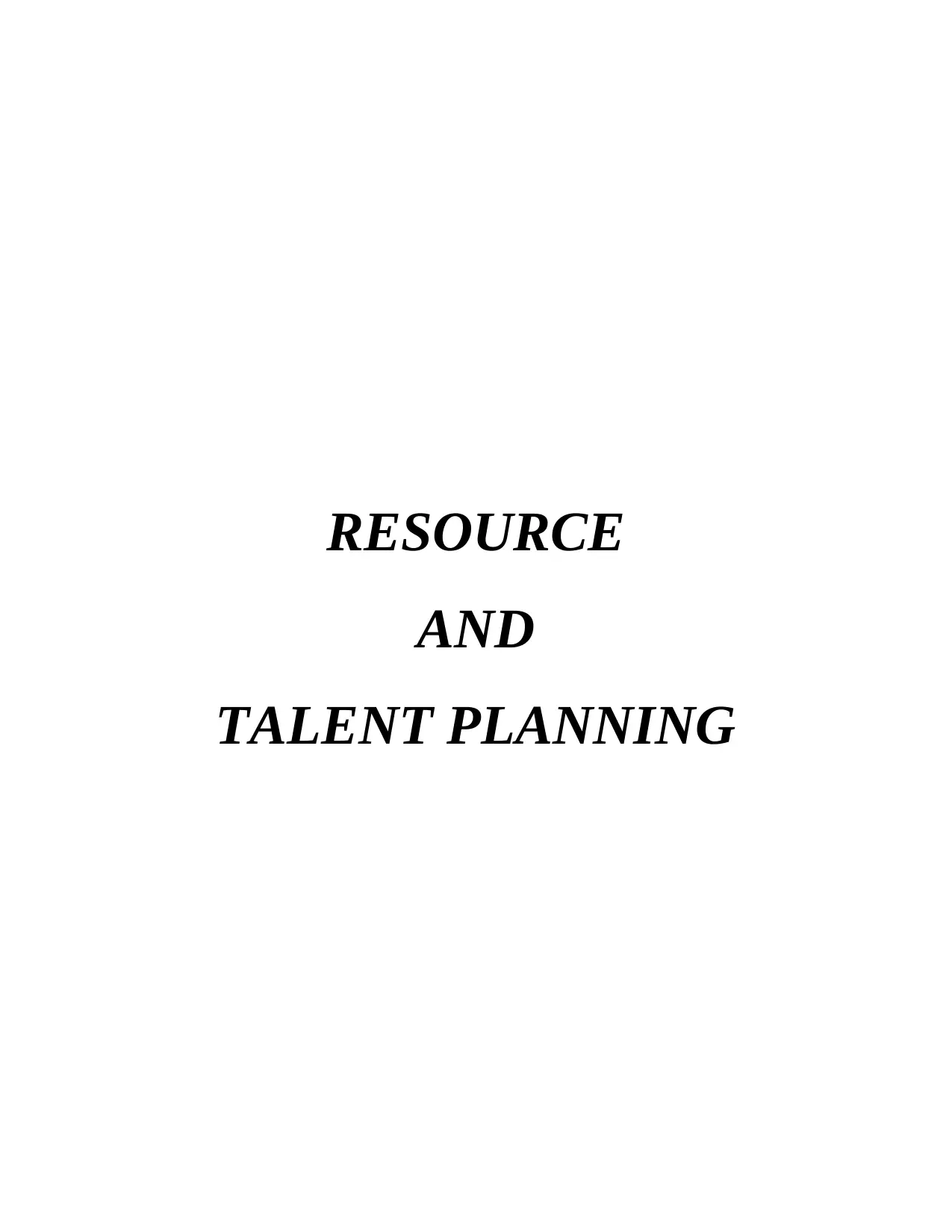
RESOURCE
AND
TALENT PLANNING
AND
TALENT PLANNING
Secure Best Marks with AI Grader
Need help grading? Try our AI Grader for instant feedback on your assignments.
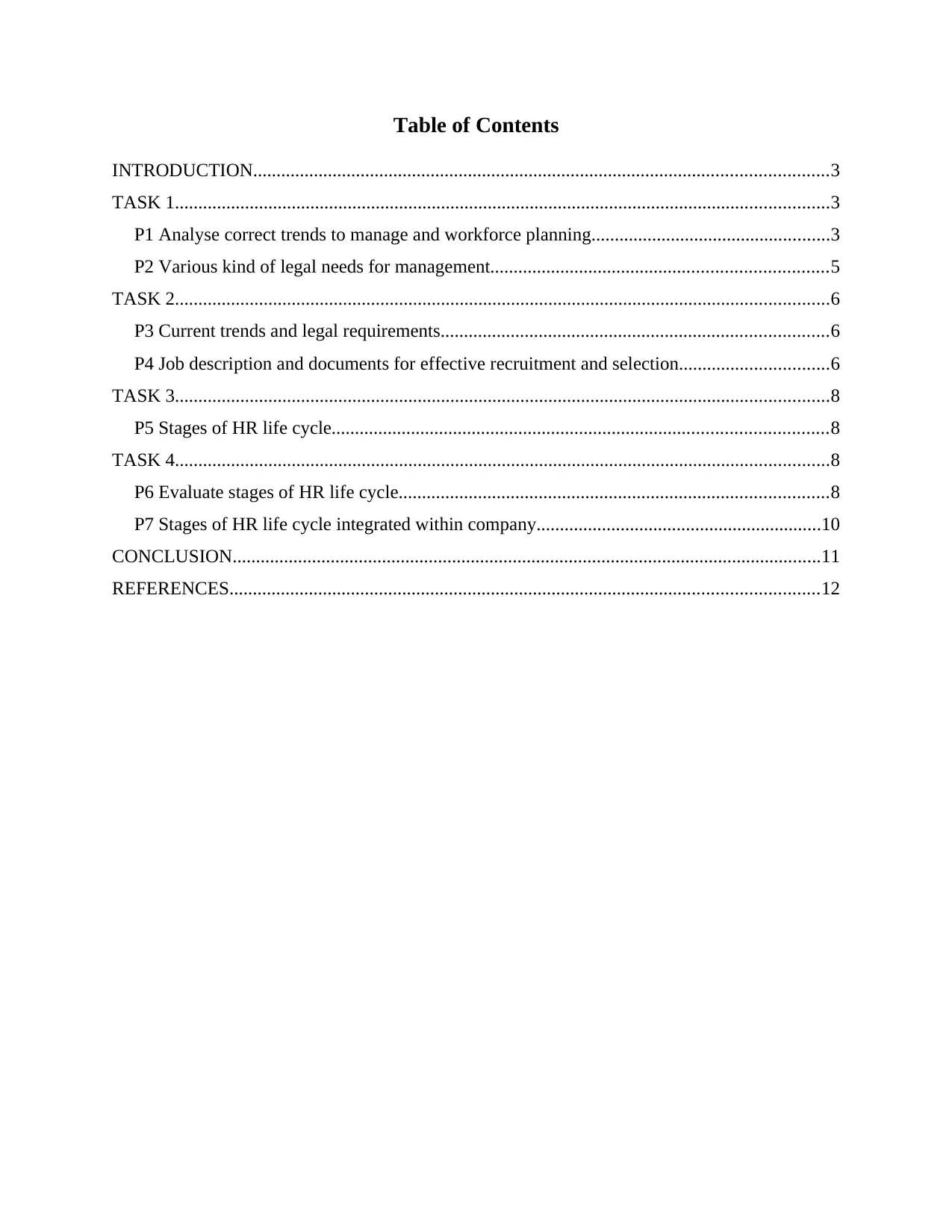
Table of Contents
INTRODUCTION...........................................................................................................................3
TASK 1............................................................................................................................................3
P1 Analyse correct trends to manage and workforce planning...................................................3
P2 Various kind of legal needs for management........................................................................5
TASK 2............................................................................................................................................6
P3 Current trends and legal requirements...................................................................................6
P4 Job description and documents for effective recruitment and selection................................6
TASK 3............................................................................................................................................8
P5 Stages of HR life cycle..........................................................................................................8
TASK 4............................................................................................................................................8
P6 Evaluate stages of HR life cycle............................................................................................8
P7 Stages of HR life cycle integrated within company.............................................................10
CONCLUSION..............................................................................................................................11
REFERENCES..............................................................................................................................12
INTRODUCTION...........................................................................................................................3
TASK 1............................................................................................................................................3
P1 Analyse correct trends to manage and workforce planning...................................................3
P2 Various kind of legal needs for management........................................................................5
TASK 2............................................................................................................................................6
P3 Current trends and legal requirements...................................................................................6
P4 Job description and documents for effective recruitment and selection................................6
TASK 3............................................................................................................................................8
P5 Stages of HR life cycle..........................................................................................................8
TASK 4............................................................................................................................................8
P6 Evaluate stages of HR life cycle............................................................................................8
P7 Stages of HR life cycle integrated within company.............................................................10
CONCLUSION..............................................................................................................................11
REFERENCES..............................................................................................................................12
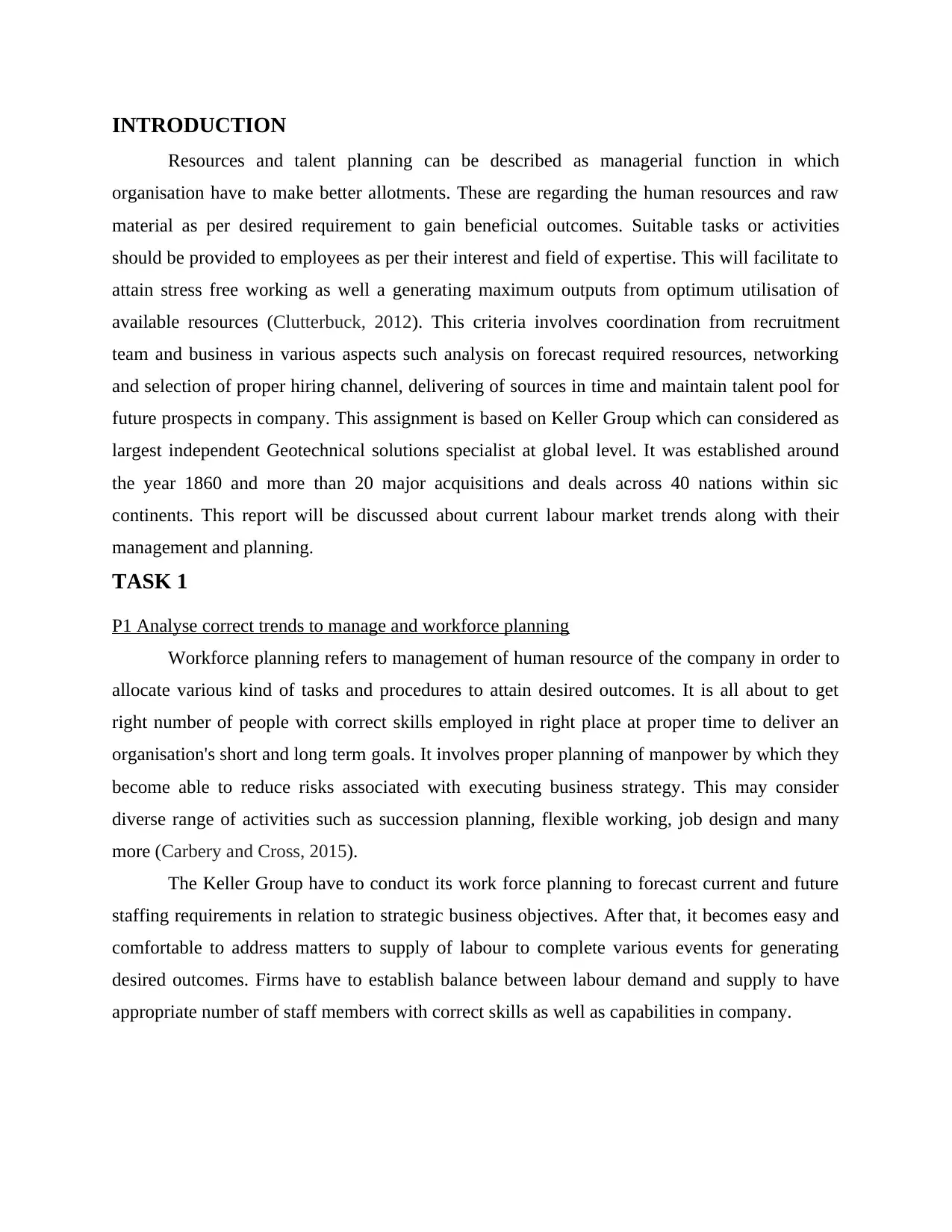
INTRODUCTION
Resources and talent planning can be described as managerial function in which
organisation have to make better allotments. These are regarding the human resources and raw
material as per desired requirement to gain beneficial outcomes. Suitable tasks or activities
should be provided to employees as per their interest and field of expertise. This will facilitate to
attain stress free working as well a generating maximum outputs from optimum utilisation of
available resources (Clutterbuck, 2012). This criteria involves coordination from recruitment
team and business in various aspects such analysis on forecast required resources, networking
and selection of proper hiring channel, delivering of sources in time and maintain talent pool for
future prospects in company. This assignment is based on Keller Group which can considered as
largest independent Geotechnical solutions specialist at global level. It was established around
the year 1860 and more than 20 major acquisitions and deals across 40 nations within sic
continents. This report will be discussed about current labour market trends along with their
management and planning.
TASK 1
P1 Analyse correct trends to manage and workforce planning
Workforce planning refers to management of human resource of the company in order to
allocate various kind of tasks and procedures to attain desired outcomes. It is all about to get
right number of people with correct skills employed in right place at proper time to deliver an
organisation's short and long term goals. It involves proper planning of manpower by which they
become able to reduce risks associated with executing business strategy. This may consider
diverse range of activities such as succession planning, flexible working, job design and many
more (Carbery and Cross, 2015).
The Keller Group have to conduct its work force planning to forecast current and future
staffing requirements in relation to strategic business objectives. After that, it becomes easy and
comfortable to address matters to supply of labour to complete various events for generating
desired outcomes. Firms have to establish balance between labour demand and supply to have
appropriate number of staff members with correct skills as well as capabilities in company.
Resources and talent planning can be described as managerial function in which
organisation have to make better allotments. These are regarding the human resources and raw
material as per desired requirement to gain beneficial outcomes. Suitable tasks or activities
should be provided to employees as per their interest and field of expertise. This will facilitate to
attain stress free working as well a generating maximum outputs from optimum utilisation of
available resources (Clutterbuck, 2012). This criteria involves coordination from recruitment
team and business in various aspects such analysis on forecast required resources, networking
and selection of proper hiring channel, delivering of sources in time and maintain talent pool for
future prospects in company. This assignment is based on Keller Group which can considered as
largest independent Geotechnical solutions specialist at global level. It was established around
the year 1860 and more than 20 major acquisitions and deals across 40 nations within sic
continents. This report will be discussed about current labour market trends along with their
management and planning.
TASK 1
P1 Analyse correct trends to manage and workforce planning
Workforce planning refers to management of human resource of the company in order to
allocate various kind of tasks and procedures to attain desired outcomes. It is all about to get
right number of people with correct skills employed in right place at proper time to deliver an
organisation's short and long term goals. It involves proper planning of manpower by which they
become able to reduce risks associated with executing business strategy. This may consider
diverse range of activities such as succession planning, flexible working, job design and many
more (Carbery and Cross, 2015).
The Keller Group have to conduct its work force planning to forecast current and future
staffing requirements in relation to strategic business objectives. After that, it becomes easy and
comfortable to address matters to supply of labour to complete various events for generating
desired outcomes. Firms have to establish balance between labour demand and supply to have
appropriate number of staff members with correct skills as well as capabilities in company.
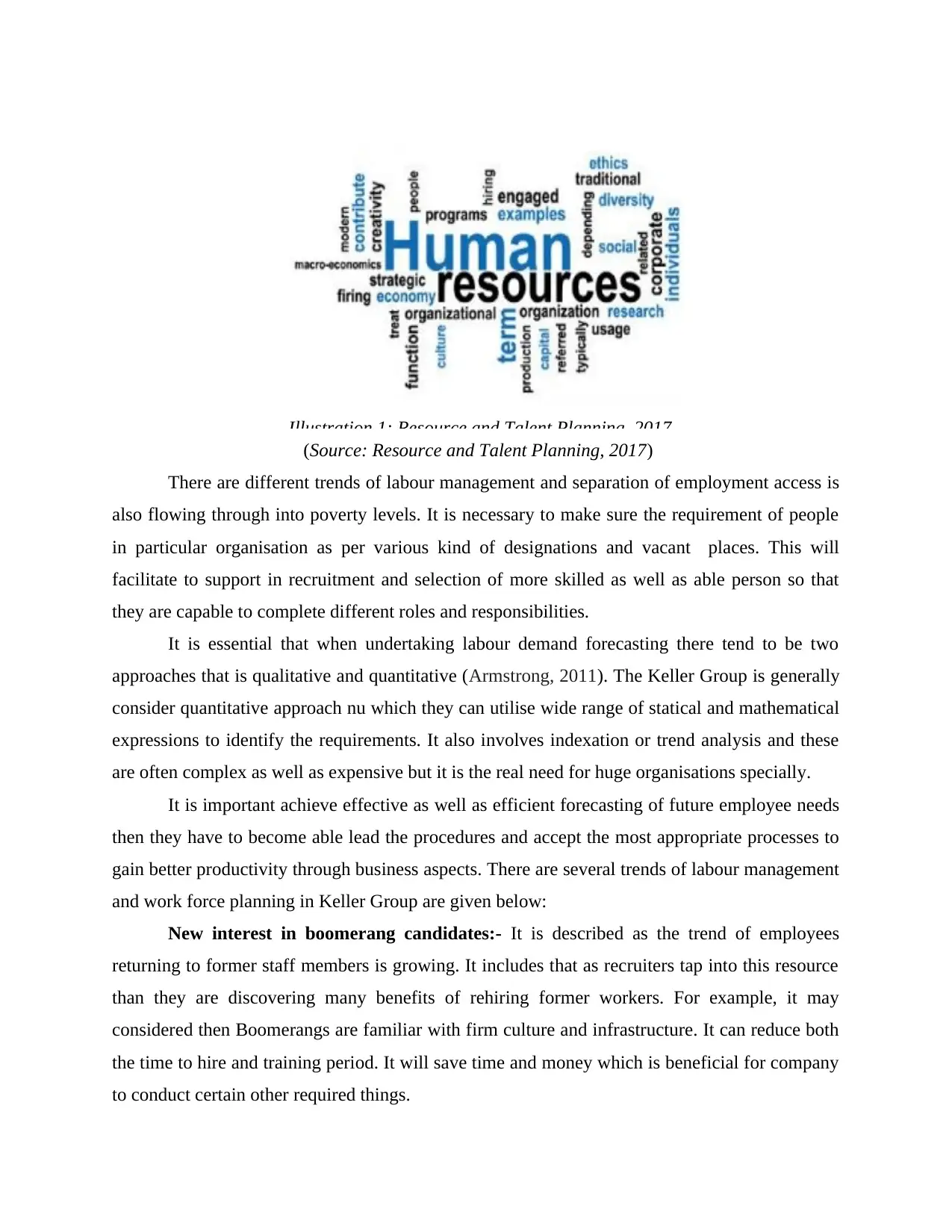
(Source: Resource and Talent Planning, 2017)
There are different trends of labour management and separation of employment access is
also flowing through into poverty levels. It is necessary to make sure the requirement of people
in particular organisation as per various kind of designations and vacant places. This will
facilitate to support in recruitment and selection of more skilled as well as able person so that
they are capable to complete different roles and responsibilities.
It is essential that when undertaking labour demand forecasting there tend to be two
approaches that is qualitative and quantitative (Armstrong, 2011). The Keller Group is generally
consider quantitative approach nu which they can utilise wide range of statical and mathematical
expressions to identify the requirements. It also involves indexation or trend analysis and these
are often complex as well as expensive but it is the real need for huge organisations specially.
It is important achieve effective as well as efficient forecasting of future employee needs
then they have to become able lead the procedures and accept the most appropriate processes to
gain better productivity through business aspects. There are several trends of labour management
and work force planning in Keller Group are given below:
New interest in boomerang candidates:- It is described as the trend of employees
returning to former staff members is growing. It includes that as recruiters tap into this resource
than they are discovering many benefits of rehiring former workers. For example, it may
considered then Boomerangs are familiar with firm culture and infrastructure. It can reduce both
the time to hire and training period. It will save time and money which is beneficial for company
to conduct certain other required things.
Illustration 1: Resource and Talent Planning, 2017
There are different trends of labour management and separation of employment access is
also flowing through into poverty levels. It is necessary to make sure the requirement of people
in particular organisation as per various kind of designations and vacant places. This will
facilitate to support in recruitment and selection of more skilled as well as able person so that
they are capable to complete different roles and responsibilities.
It is essential that when undertaking labour demand forecasting there tend to be two
approaches that is qualitative and quantitative (Armstrong, 2011). The Keller Group is generally
consider quantitative approach nu which they can utilise wide range of statical and mathematical
expressions to identify the requirements. It also involves indexation or trend analysis and these
are often complex as well as expensive but it is the real need for huge organisations specially.
It is important achieve effective as well as efficient forecasting of future employee needs
then they have to become able lead the procedures and accept the most appropriate processes to
gain better productivity through business aspects. There are several trends of labour management
and work force planning in Keller Group are given below:
New interest in boomerang candidates:- It is described as the trend of employees
returning to former staff members is growing. It includes that as recruiters tap into this resource
than they are discovering many benefits of rehiring former workers. For example, it may
considered then Boomerangs are familiar with firm culture and infrastructure. It can reduce both
the time to hire and training period. It will save time and money which is beneficial for company
to conduct certain other required things.
Illustration 1: Resource and Talent Planning, 2017
Secure Best Marks with AI Grader
Need help grading? Try our AI Grader for instant feedback on your assignments.
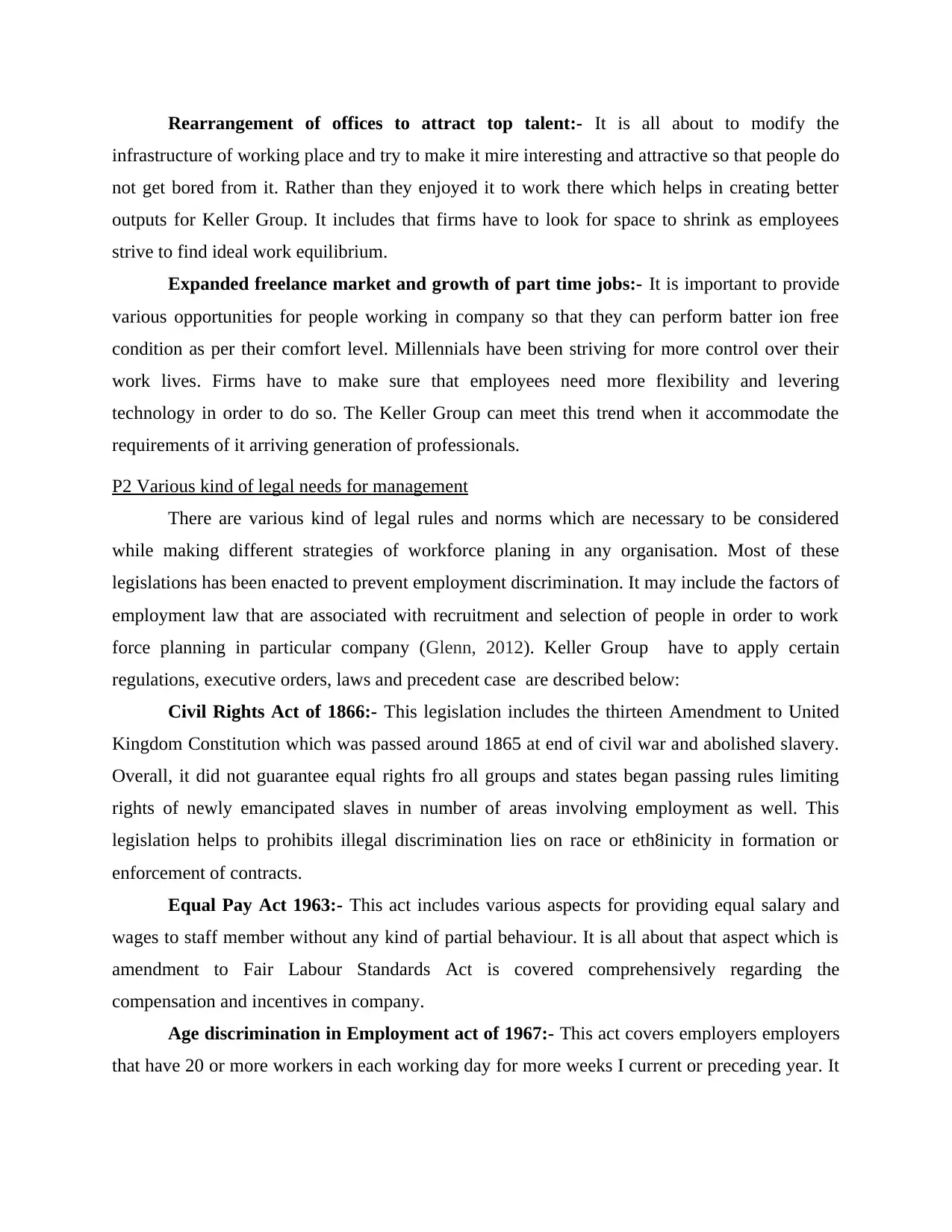
Rearrangement of offices to attract top talent:- It is all about to modify the
infrastructure of working place and try to make it mire interesting and attractive so that people do
not get bored from it. Rather than they enjoyed it to work there which helps in creating better
outputs for Keller Group. It includes that firms have to look for space to shrink as employees
strive to find ideal work equilibrium.
Expanded freelance market and growth of part time jobs:- It is important to provide
various opportunities for people working in company so that they can perform batter ion free
condition as per their comfort level. Millennials have been striving for more control over their
work lives. Firms have to make sure that employees need more flexibility and levering
technology in order to do so. The Keller Group can meet this trend when it accommodate the
requirements of it arriving generation of professionals.
P2 Various kind of legal needs for management
There are various kind of legal rules and norms which are necessary to be considered
while making different strategies of workforce planing in any organisation. Most of these
legislations has been enacted to prevent employment discrimination. It may include the factors of
employment law that are associated with recruitment and selection of people in order to work
force planning in particular company (Glenn, 2012). Keller Group have to apply certain
regulations, executive orders, laws and precedent case are described below:
Civil Rights Act of 1866:- This legislation includes the thirteen Amendment to United
Kingdom Constitution which was passed around 1865 at end of civil war and abolished slavery.
Overall, it did not guarantee equal rights fro all groups and states began passing rules limiting
rights of newly emancipated slaves in number of areas involving employment as well. This
legislation helps to prohibits illegal discrimination lies on race or eth8inicity in formation or
enforcement of contracts.
Equal Pay Act 1963:- This act includes various aspects for providing equal salary and
wages to staff member without any kind of partial behaviour. It is all about that aspect which is
amendment to Fair Labour Standards Act is covered comprehensively regarding the
compensation and incentives in company.
Age discrimination in Employment act of 1967:- This act covers employers employers
that have 20 or more workers in each working day for more weeks I current or preceding year. It
infrastructure of working place and try to make it mire interesting and attractive so that people do
not get bored from it. Rather than they enjoyed it to work there which helps in creating better
outputs for Keller Group. It includes that firms have to look for space to shrink as employees
strive to find ideal work equilibrium.
Expanded freelance market and growth of part time jobs:- It is important to provide
various opportunities for people working in company so that they can perform batter ion free
condition as per their comfort level. Millennials have been striving for more control over their
work lives. Firms have to make sure that employees need more flexibility and levering
technology in order to do so. The Keller Group can meet this trend when it accommodate the
requirements of it arriving generation of professionals.
P2 Various kind of legal needs for management
There are various kind of legal rules and norms which are necessary to be considered
while making different strategies of workforce planing in any organisation. Most of these
legislations has been enacted to prevent employment discrimination. It may include the factors of
employment law that are associated with recruitment and selection of people in order to work
force planning in particular company (Glenn, 2012). Keller Group have to apply certain
regulations, executive orders, laws and precedent case are described below:
Civil Rights Act of 1866:- This legislation includes the thirteen Amendment to United
Kingdom Constitution which was passed around 1865 at end of civil war and abolished slavery.
Overall, it did not guarantee equal rights fro all groups and states began passing rules limiting
rights of newly emancipated slaves in number of areas involving employment as well. This
legislation helps to prohibits illegal discrimination lies on race or eth8inicity in formation or
enforcement of contracts.
Equal Pay Act 1963:- This act includes various aspects for providing equal salary and
wages to staff member without any kind of partial behaviour. It is all about that aspect which is
amendment to Fair Labour Standards Act is covered comprehensively regarding the
compensation and incentives in company.
Age discrimination in Employment act of 1967:- This act covers employers employers
that have 20 or more workers in each working day for more weeks I current or preceding year. It
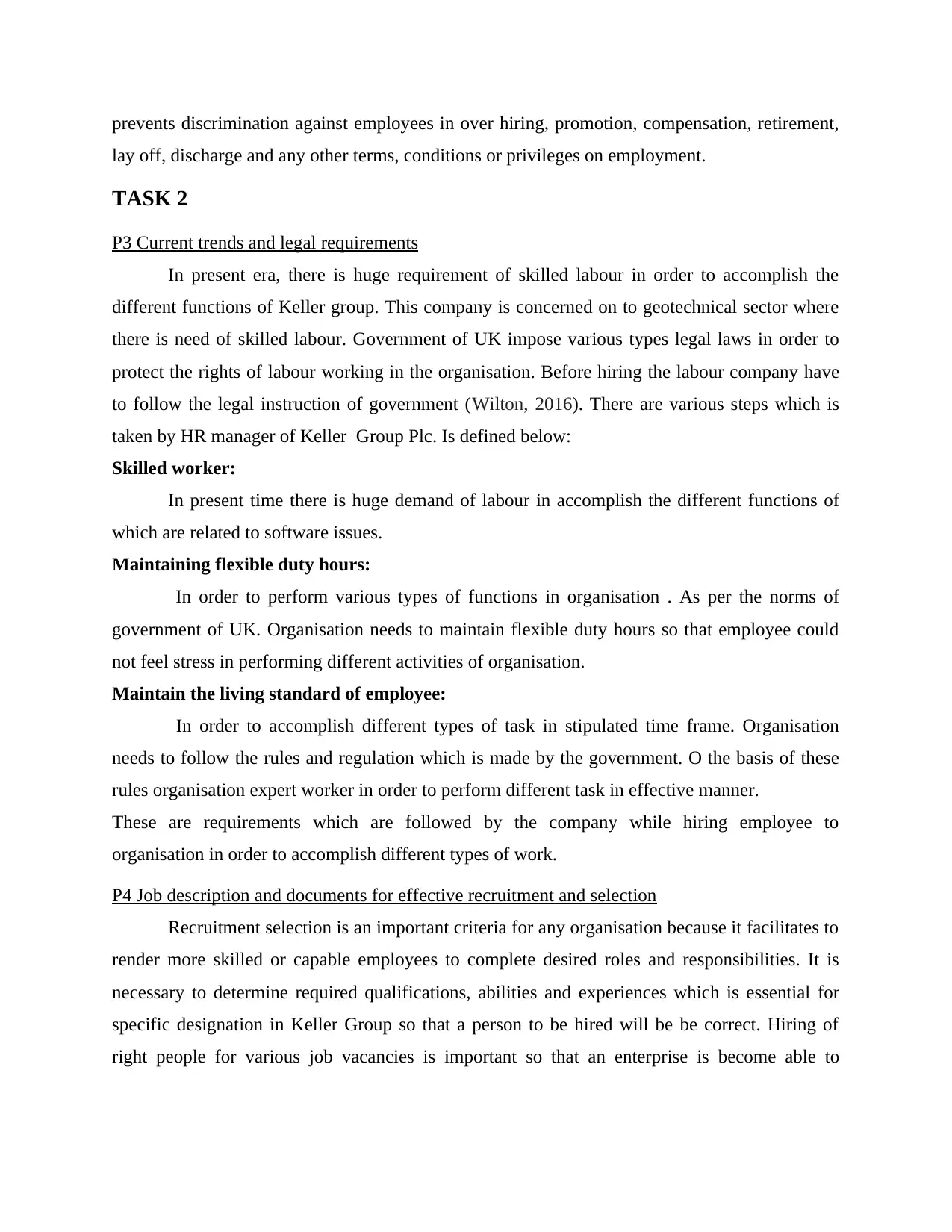
prevents discrimination against employees in over hiring, promotion, compensation, retirement,
lay off, discharge and any other terms, conditions or privileges on employment.
TASK 2
P3 Current trends and legal requirements
In present era, there is huge requirement of skilled labour in order to accomplish the
different functions of Keller group. This company is concerned on to geotechnical sector where
there is need of skilled labour. Government of UK impose various types legal laws in order to
protect the rights of labour working in the organisation. Before hiring the labour company have
to follow the legal instruction of government (Wilton, 2016). There are various steps which is
taken by HR manager of Keller Group Plc. Is defined below:
Skilled worker:
In present time there is huge demand of labour in accomplish the different functions of
which are related to software issues.
Maintaining flexible duty hours:
In order to perform various types of functions in organisation . As per the norms of
government of UK. Organisation needs to maintain flexible duty hours so that employee could
not feel stress in performing different activities of organisation.
Maintain the living standard of employee:
In order to accomplish different types of task in stipulated time frame. Organisation
needs to follow the rules and regulation which is made by the government. O the basis of these
rules organisation expert worker in order to perform different task in effective manner.
These are requirements which are followed by the company while hiring employee to
organisation in order to accomplish different types of work.
P4 Job description and documents for effective recruitment and selection
Recruitment selection is an important criteria for any organisation because it facilitates to
render more skilled or capable employees to complete desired roles and responsibilities. It is
necessary to determine required qualifications, abilities and experiences which is essential for
specific designation in Keller Group so that a person to be hired will be be correct. Hiring of
right people for various job vacancies is important so that an enterprise is become able to
lay off, discharge and any other terms, conditions or privileges on employment.
TASK 2
P3 Current trends and legal requirements
In present era, there is huge requirement of skilled labour in order to accomplish the
different functions of Keller group. This company is concerned on to geotechnical sector where
there is need of skilled labour. Government of UK impose various types legal laws in order to
protect the rights of labour working in the organisation. Before hiring the labour company have
to follow the legal instruction of government (Wilton, 2016). There are various steps which is
taken by HR manager of Keller Group Plc. Is defined below:
Skilled worker:
In present time there is huge demand of labour in accomplish the different functions of
which are related to software issues.
Maintaining flexible duty hours:
In order to perform various types of functions in organisation . As per the norms of
government of UK. Organisation needs to maintain flexible duty hours so that employee could
not feel stress in performing different activities of organisation.
Maintain the living standard of employee:
In order to accomplish different types of task in stipulated time frame. Organisation
needs to follow the rules and regulation which is made by the government. O the basis of these
rules organisation expert worker in order to perform different task in effective manner.
These are requirements which are followed by the company while hiring employee to
organisation in order to accomplish different types of work.
P4 Job description and documents for effective recruitment and selection
Recruitment selection is an important criteria for any organisation because it facilitates to
render more skilled or capable employees to complete desired roles and responsibilities. It is
necessary to determine required qualifications, abilities and experiences which is essential for
specific designation in Keller Group so that a person to be hired will be be correct. Hiring of
right people for various job vacancies is important so that an enterprise is become able to
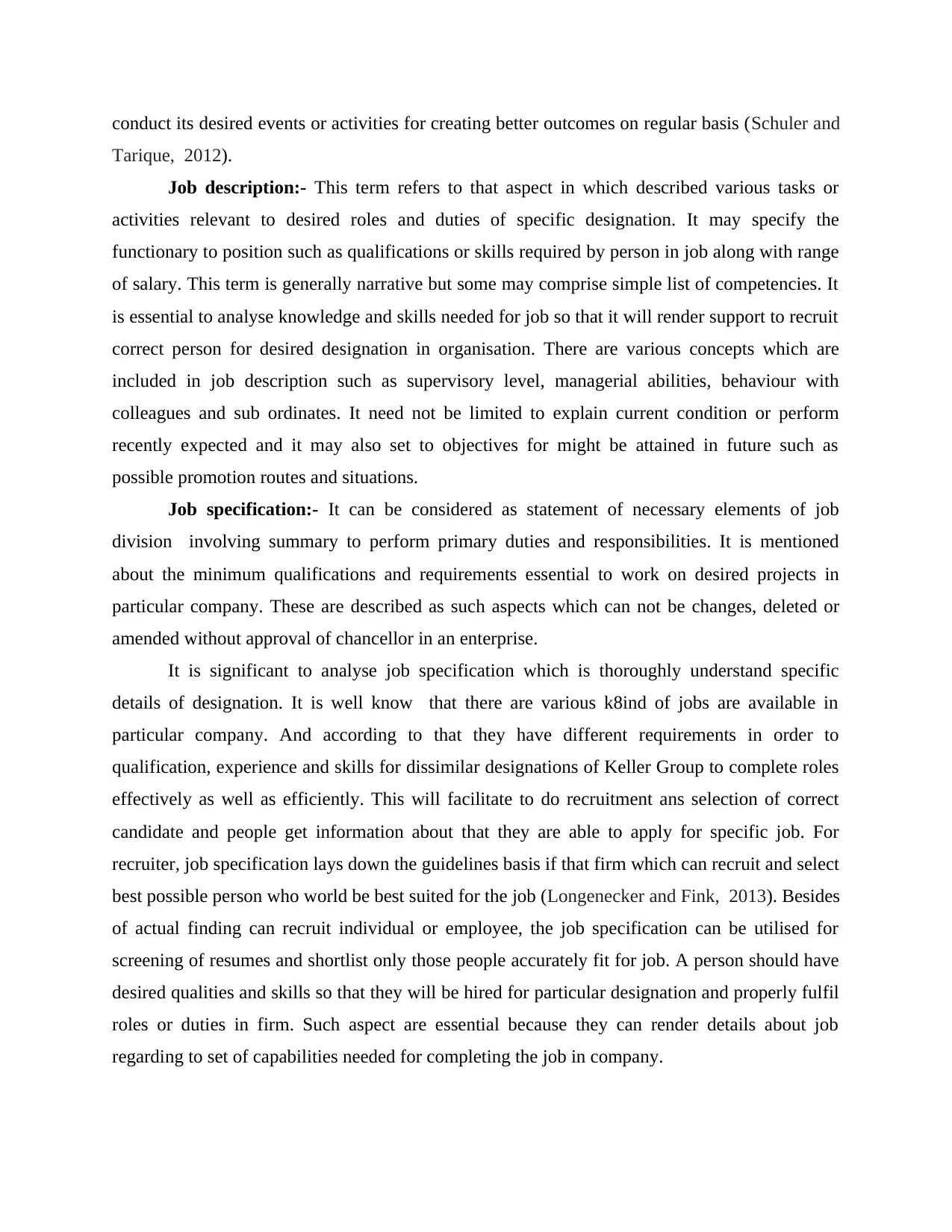
conduct its desired events or activities for creating better outcomes on regular basis (Schuler and
Tarique, 2012).
Job description:- This term refers to that aspect in which described various tasks or
activities relevant to desired roles and duties of specific designation. It may specify the
functionary to position such as qualifications or skills required by person in job along with range
of salary. This term is generally narrative but some may comprise simple list of competencies. It
is essential to analyse knowledge and skills needed for job so that it will render support to recruit
correct person for desired designation in organisation. There are various concepts which are
included in job description such as supervisory level, managerial abilities, behaviour with
colleagues and sub ordinates. It need not be limited to explain current condition or perform
recently expected and it may also set to objectives for might be attained in future such as
possible promotion routes and situations.
Job specification:- It can be considered as statement of necessary elements of job
division involving summary to perform primary duties and responsibilities. It is mentioned
about the minimum qualifications and requirements essential to work on desired projects in
particular company. These are described as such aspects which can not be changes, deleted or
amended without approval of chancellor in an enterprise.
It is significant to analyse job specification which is thoroughly understand specific
details of designation. It is well know that there are various k8ind of jobs are available in
particular company. And according to that they have different requirements in order to
qualification, experience and skills for dissimilar designations of Keller Group to complete roles
effectively as well as efficiently. This will facilitate to do recruitment ans selection of correct
candidate and people get information about that they are able to apply for specific job. For
recruiter, job specification lays down the guidelines basis if that firm which can recruit and select
best possible person who world be best suited for the job (Longenecker and Fink, 2013). Besides
of actual finding can recruit individual or employee, the job specification can be utilised for
screening of resumes and shortlist only those people accurately fit for job. A person should have
desired qualities and skills so that they will be hired for particular designation and properly fulfil
roles or duties in firm. Such aspect are essential because they can render details about job
regarding to set of capabilities needed for completing the job in company.
Tarique, 2012).
Job description:- This term refers to that aspect in which described various tasks or
activities relevant to desired roles and duties of specific designation. It may specify the
functionary to position such as qualifications or skills required by person in job along with range
of salary. This term is generally narrative but some may comprise simple list of competencies. It
is essential to analyse knowledge and skills needed for job so that it will render support to recruit
correct person for desired designation in organisation. There are various concepts which are
included in job description such as supervisory level, managerial abilities, behaviour with
colleagues and sub ordinates. It need not be limited to explain current condition or perform
recently expected and it may also set to objectives for might be attained in future such as
possible promotion routes and situations.
Job specification:- It can be considered as statement of necessary elements of job
division involving summary to perform primary duties and responsibilities. It is mentioned
about the minimum qualifications and requirements essential to work on desired projects in
particular company. These are described as such aspects which can not be changes, deleted or
amended without approval of chancellor in an enterprise.
It is significant to analyse job specification which is thoroughly understand specific
details of designation. It is well know that there are various k8ind of jobs are available in
particular company. And according to that they have different requirements in order to
qualification, experience and skills for dissimilar designations of Keller Group to complete roles
effectively as well as efficiently. This will facilitate to do recruitment ans selection of correct
candidate and people get information about that they are able to apply for specific job. For
recruiter, job specification lays down the guidelines basis if that firm which can recruit and select
best possible person who world be best suited for the job (Longenecker and Fink, 2013). Besides
of actual finding can recruit individual or employee, the job specification can be utilised for
screening of resumes and shortlist only those people accurately fit for job. A person should have
desired qualities and skills so that they will be hired for particular designation and properly fulfil
roles or duties in firm. Such aspect are essential because they can render details about job
regarding to set of capabilities needed for completing the job in company.
Paraphrase This Document
Need a fresh take? Get an instant paraphrase of this document with our AI Paraphraser
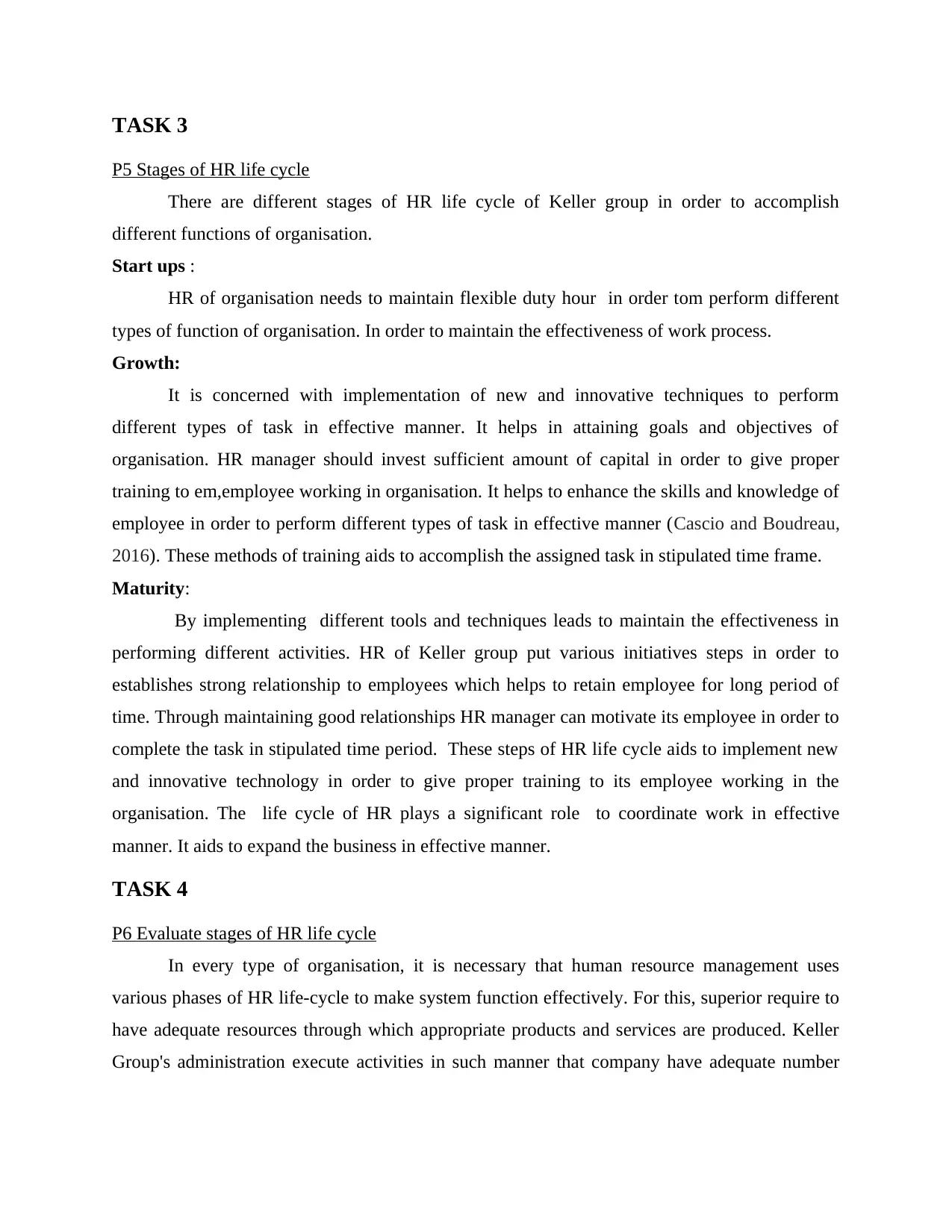
TASK 3
P5 Stages of HR life cycle
There are different stages of HR life cycle of Keller group in order to accomplish
different functions of organisation.
Start ups :
HR of organisation needs to maintain flexible duty hour in order tom perform different
types of function of organisation. In order to maintain the effectiveness of work process.
Growth:
It is concerned with implementation of new and innovative techniques to perform
different types of task in effective manner. It helps in attaining goals and objectives of
organisation. HR manager should invest sufficient amount of capital in order to give proper
training to em,employee working in organisation. It helps to enhance the skills and knowledge of
employee in order to perform different types of task in effective manner (Cascio and Boudreau,
2016). These methods of training aids to accomplish the assigned task in stipulated time frame.
Maturity:
By implementing different tools and techniques leads to maintain the effectiveness in
performing different activities. HR of Keller group put various initiatives steps in order to
establishes strong relationship to employees which helps to retain employee for long period of
time. Through maintaining good relationships HR manager can motivate its employee in order to
complete the task in stipulated time period. These steps of HR life cycle aids to implement new
and innovative technology in order to give proper training to its employee working in the
organisation. The life cycle of HR plays a significant role to coordinate work in effective
manner. It aids to expand the business in effective manner.
TASK 4
P6 Evaluate stages of HR life cycle
In every type of organisation, it is necessary that human resource management uses
various phases of HR life-cycle to make system function effectively. For this, superior require to
have adequate resources through which appropriate products and services are produced. Keller
Group's administration execute activities in such manner that company have adequate number
P5 Stages of HR life cycle
There are different stages of HR life cycle of Keller group in order to accomplish
different functions of organisation.
Start ups :
HR of organisation needs to maintain flexible duty hour in order tom perform different
types of function of organisation. In order to maintain the effectiveness of work process.
Growth:
It is concerned with implementation of new and innovative techniques to perform
different types of task in effective manner. It helps in attaining goals and objectives of
organisation. HR manager should invest sufficient amount of capital in order to give proper
training to em,employee working in organisation. It helps to enhance the skills and knowledge of
employee in order to perform different types of task in effective manner (Cascio and Boudreau,
2016). These methods of training aids to accomplish the assigned task in stipulated time frame.
Maturity:
By implementing different tools and techniques leads to maintain the effectiveness in
performing different activities. HR of Keller group put various initiatives steps in order to
establishes strong relationship to employees which helps to retain employee for long period of
time. Through maintaining good relationships HR manager can motivate its employee in order to
complete the task in stipulated time period. These steps of HR life cycle aids to implement new
and innovative technology in order to give proper training to its employee working in the
organisation. The life cycle of HR plays a significant role to coordinate work in effective
manner. It aids to expand the business in effective manner.
TASK 4
P6 Evaluate stages of HR life cycle
In every type of organisation, it is necessary that human resource management uses
various phases of HR life-cycle to make system function effectively. For this, superior require to
have adequate resources through which appropriate products and services are produced. Keller
Group's administration execute activities in such manner that company have adequate number
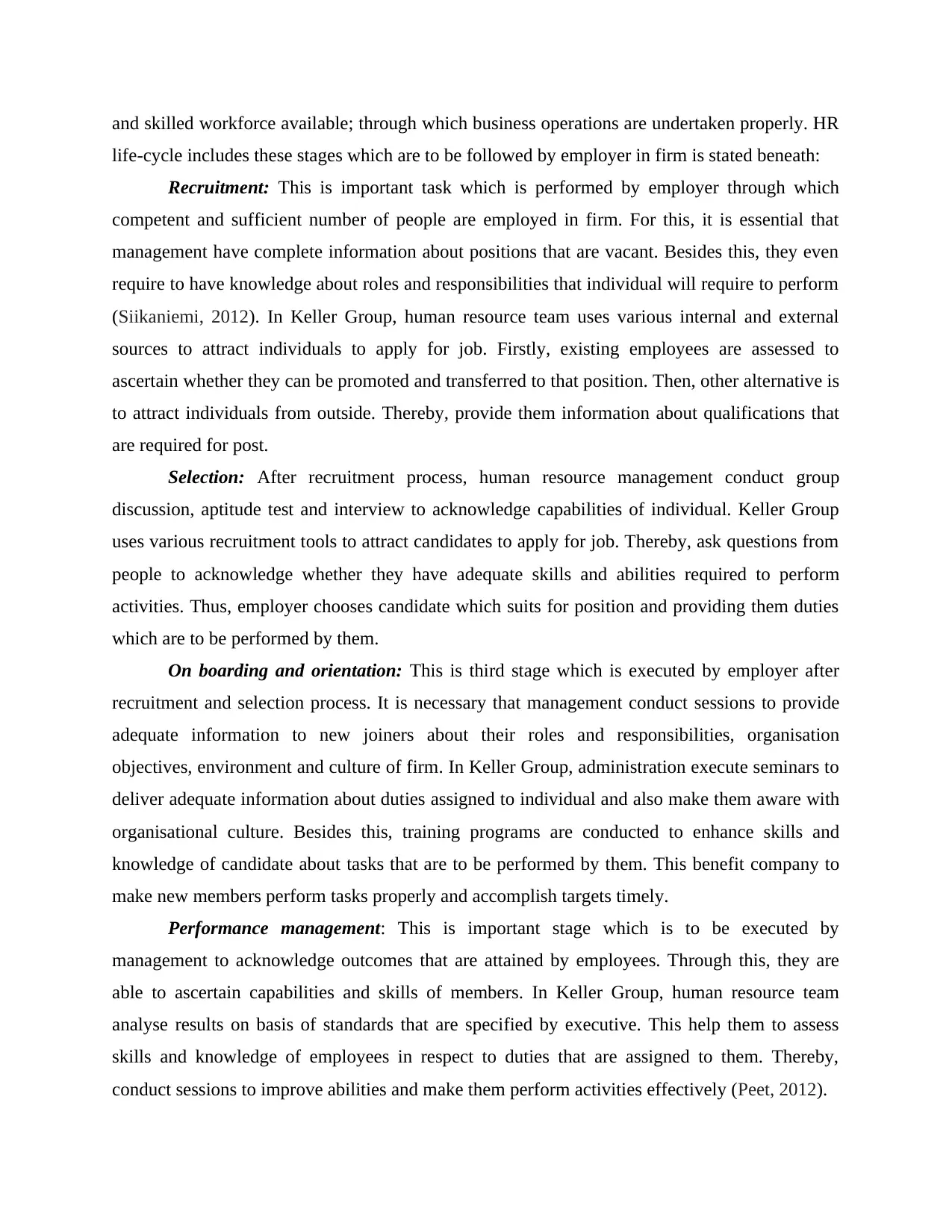
and skilled workforce available; through which business operations are undertaken properly. HR
life-cycle includes these stages which are to be followed by employer in firm is stated beneath:
Recruitment: This is important task which is performed by employer through which
competent and sufficient number of people are employed in firm. For this, it is essential that
management have complete information about positions that are vacant. Besides this, they even
require to have knowledge about roles and responsibilities that individual will require to perform
(Siikaniemi, 2012). In Keller Group, human resource team uses various internal and external
sources to attract individuals to apply for job. Firstly, existing employees are assessed to
ascertain whether they can be promoted and transferred to that position. Then, other alternative is
to attract individuals from outside. Thereby, provide them information about qualifications that
are required for post.
Selection: After recruitment process, human resource management conduct group
discussion, aptitude test and interview to acknowledge capabilities of individual. Keller Group
uses various recruitment tools to attract candidates to apply for job. Thereby, ask questions from
people to acknowledge whether they have adequate skills and abilities required to perform
activities. Thus, employer chooses candidate which suits for position and providing them duties
which are to be performed by them.
On boarding and orientation: This is third stage which is executed by employer after
recruitment and selection process. It is necessary that management conduct sessions to provide
adequate information to new joiners about their roles and responsibilities, organisation
objectives, environment and culture of firm. In Keller Group, administration execute seminars to
deliver adequate information about duties assigned to individual and also make them aware with
organisational culture. Besides this, training programs are conducted to enhance skills and
knowledge of candidate about tasks that are to be performed by them. This benefit company to
make new members perform tasks properly and accomplish targets timely.
Performance management: This is important stage which is to be executed by
management to acknowledge outcomes that are attained by employees. Through this, they are
able to ascertain capabilities and skills of members. In Keller Group, human resource team
analyse results on basis of standards that are specified by executive. This help them to assess
skills and knowledge of employees in respect to duties that are assigned to them. Thereby,
conduct sessions to improve abilities and make them perform activities effectively (Peet, 2012).
life-cycle includes these stages which are to be followed by employer in firm is stated beneath:
Recruitment: This is important task which is performed by employer through which
competent and sufficient number of people are employed in firm. For this, it is essential that
management have complete information about positions that are vacant. Besides this, they even
require to have knowledge about roles and responsibilities that individual will require to perform
(Siikaniemi, 2012). In Keller Group, human resource team uses various internal and external
sources to attract individuals to apply for job. Firstly, existing employees are assessed to
ascertain whether they can be promoted and transferred to that position. Then, other alternative is
to attract individuals from outside. Thereby, provide them information about qualifications that
are required for post.
Selection: After recruitment process, human resource management conduct group
discussion, aptitude test and interview to acknowledge capabilities of individual. Keller Group
uses various recruitment tools to attract candidates to apply for job. Thereby, ask questions from
people to acknowledge whether they have adequate skills and abilities required to perform
activities. Thus, employer chooses candidate which suits for position and providing them duties
which are to be performed by them.
On boarding and orientation: This is third stage which is executed by employer after
recruitment and selection process. It is necessary that management conduct sessions to provide
adequate information to new joiners about their roles and responsibilities, organisation
objectives, environment and culture of firm. In Keller Group, administration execute seminars to
deliver adequate information about duties assigned to individual and also make them aware with
organisational culture. Besides this, training programs are conducted to enhance skills and
knowledge of candidate about tasks that are to be performed by them. This benefit company to
make new members perform tasks properly and accomplish targets timely.
Performance management: This is important stage which is to be executed by
management to acknowledge outcomes that are attained by employees. Through this, they are
able to ascertain capabilities and skills of members. In Keller Group, human resource team
analyse results on basis of standards that are specified by executive. This help them to assess
skills and knowledge of employees in respect to duties that are assigned to them. Thereby,
conduct sessions to improve abilities and make them perform activities effectively (Peet, 2012).
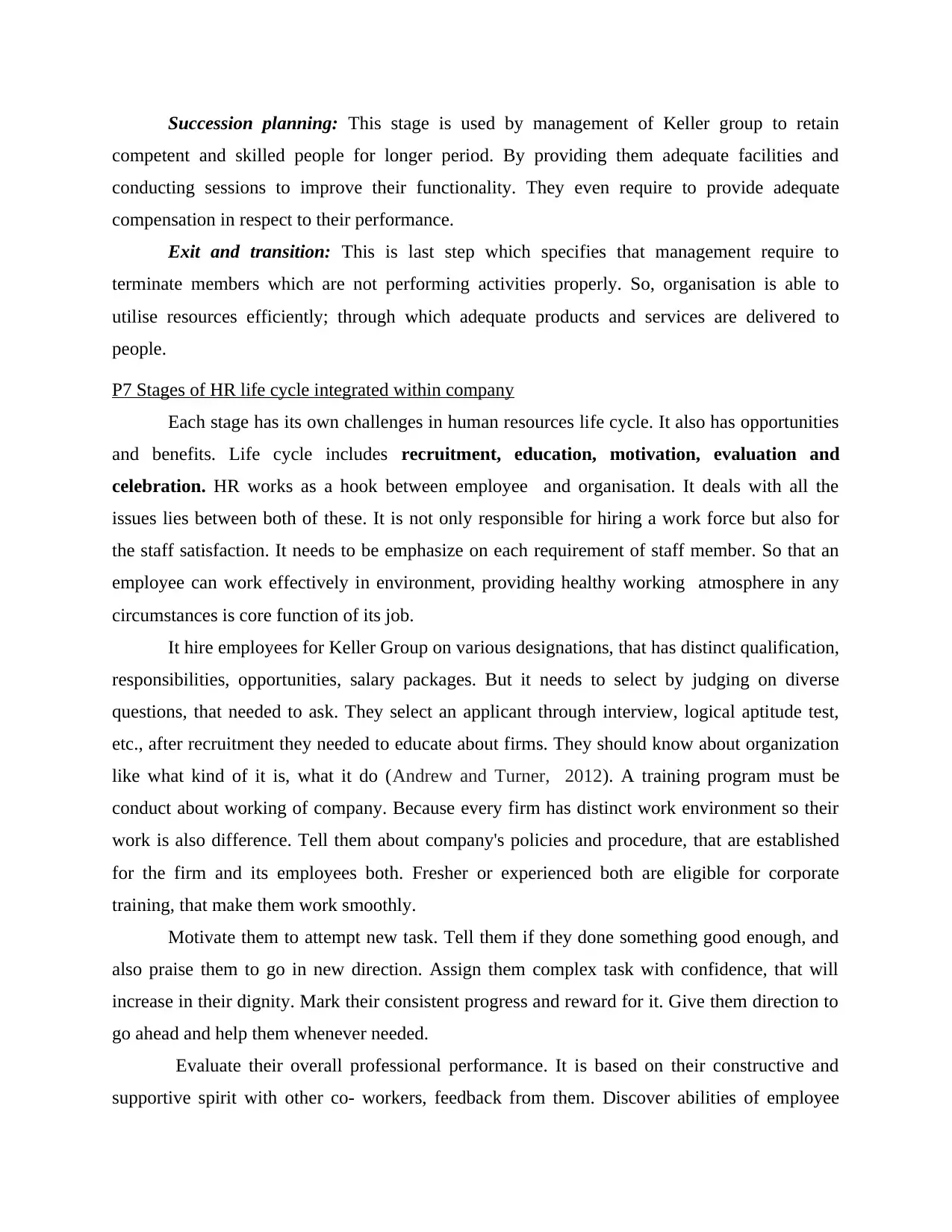
Succession planning: This stage is used by management of Keller group to retain
competent and skilled people for longer period. By providing them adequate facilities and
conducting sessions to improve their functionality. They even require to provide adequate
compensation in respect to their performance.
Exit and transition: This is last step which specifies that management require to
terminate members which are not performing activities properly. So, organisation is able to
utilise resources efficiently; through which adequate products and services are delivered to
people.
P7 Stages of HR life cycle integrated within company
Each stage has its own challenges in human resources life cycle. It also has opportunities
and benefits. Life cycle includes recruitment, education, motivation, evaluation and
celebration. HR works as a hook between employee and organisation. It deals with all the
issues lies between both of these. It is not only responsible for hiring a work force but also for
the staff satisfaction. It needs to be emphasize on each requirement of staff member. So that an
employee can work effectively in environment, providing healthy working atmosphere in any
circumstances is core function of its job.
It hire employees for Keller Group on various designations, that has distinct qualification,
responsibilities, opportunities, salary packages. But it needs to select by judging on diverse
questions, that needed to ask. They select an applicant through interview, logical aptitude test,
etc., after recruitment they needed to educate about firms. They should know about organization
like what kind of it is, what it do (Andrew and Turner, 2012). A training program must be
conduct about working of company. Because every firm has distinct work environment so their
work is also difference. Tell them about company's policies and procedure, that are established
for the firm and its employees both. Fresher or experienced both are eligible for corporate
training, that make them work smoothly.
Motivate them to attempt new task. Tell them if they done something good enough, and
also praise them to go in new direction. Assign them complex task with confidence, that will
increase in their dignity. Mark their consistent progress and reward for it. Give them direction to
go ahead and help them whenever needed.
Evaluate their overall professional performance. It is based on their constructive and
supportive spirit with other co- workers, feedback from them. Discover abilities of employee
competent and skilled people for longer period. By providing them adequate facilities and
conducting sessions to improve their functionality. They even require to provide adequate
compensation in respect to their performance.
Exit and transition: This is last step which specifies that management require to
terminate members which are not performing activities properly. So, organisation is able to
utilise resources efficiently; through which adequate products and services are delivered to
people.
P7 Stages of HR life cycle integrated within company
Each stage has its own challenges in human resources life cycle. It also has opportunities
and benefits. Life cycle includes recruitment, education, motivation, evaluation and
celebration. HR works as a hook between employee and organisation. It deals with all the
issues lies between both of these. It is not only responsible for hiring a work force but also for
the staff satisfaction. It needs to be emphasize on each requirement of staff member. So that an
employee can work effectively in environment, providing healthy working atmosphere in any
circumstances is core function of its job.
It hire employees for Keller Group on various designations, that has distinct qualification,
responsibilities, opportunities, salary packages. But it needs to select by judging on diverse
questions, that needed to ask. They select an applicant through interview, logical aptitude test,
etc., after recruitment they needed to educate about firms. They should know about organization
like what kind of it is, what it do (Andrew and Turner, 2012). A training program must be
conduct about working of company. Because every firm has distinct work environment so their
work is also difference. Tell them about company's policies and procedure, that are established
for the firm and its employees both. Fresher or experienced both are eligible for corporate
training, that make them work smoothly.
Motivate them to attempt new task. Tell them if they done something good enough, and
also praise them to go in new direction. Assign them complex task with confidence, that will
increase in their dignity. Mark their consistent progress and reward for it. Give them direction to
go ahead and help them whenever needed.
Evaluate their overall professional performance. It is based on their constructive and
supportive spirit with other co- workers, feedback from them. Discover abilities of employee
Secure Best Marks with AI Grader
Need help grading? Try our AI Grader for instant feedback on your assignments.
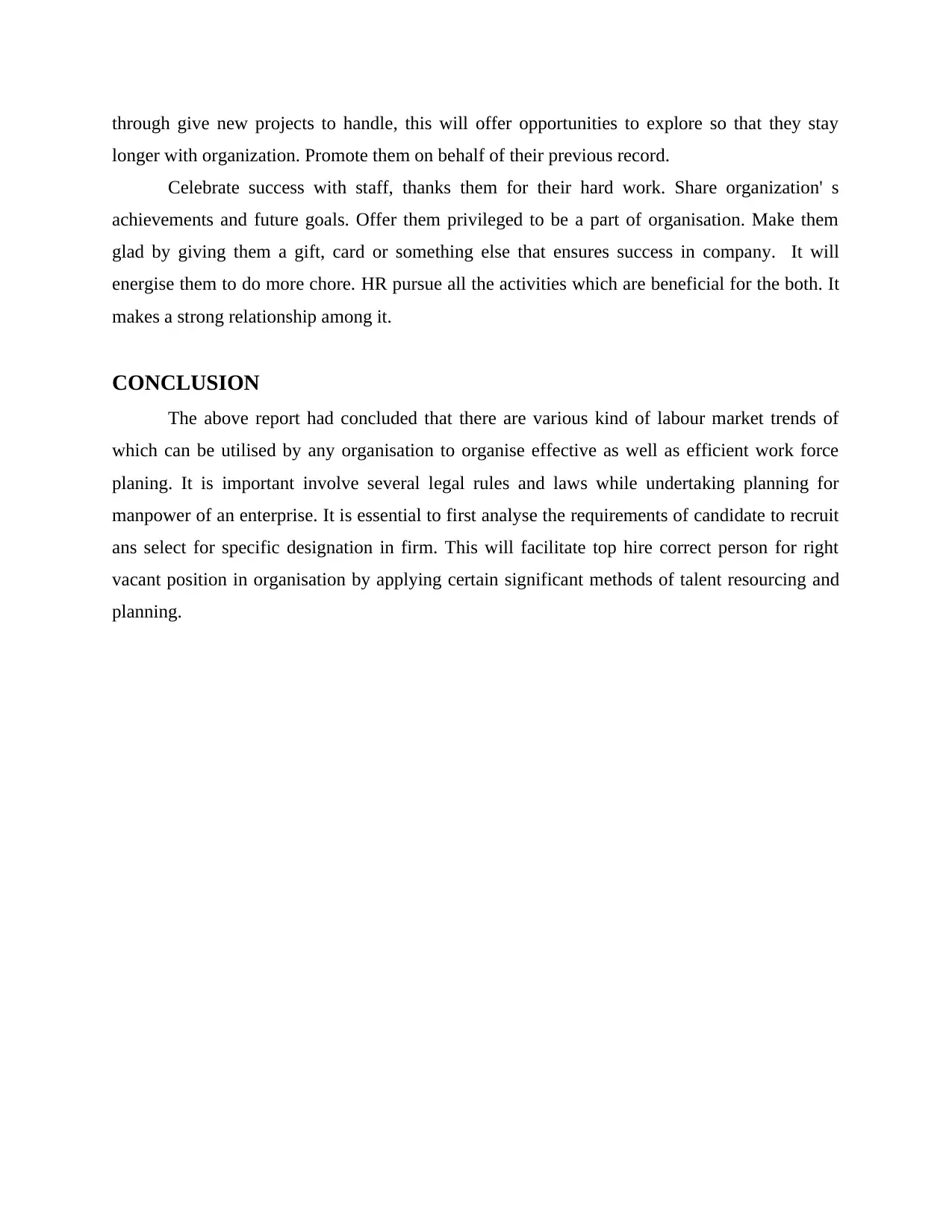
through give new projects to handle, this will offer opportunities to explore so that they stay
longer with organization. Promote them on behalf of their previous record.
Celebrate success with staff, thanks them for their hard work. Share organization' s
achievements and future goals. Offer them privileged to be a part of organisation. Make them
glad by giving them a gift, card or something else that ensures success in company. It will
energise them to do more chore. HR pursue all the activities which are beneficial for the both. It
makes a strong relationship among it.
CONCLUSION
The above report had concluded that there are various kind of labour market trends of
which can be utilised by any organisation to organise effective as well as efficient work force
planing. It is important involve several legal rules and laws while undertaking planning for
manpower of an enterprise. It is essential to first analyse the requirements of candidate to recruit
ans select for specific designation in firm. This will facilitate top hire correct person for right
vacant position in organisation by applying certain significant methods of talent resourcing and
planning.
longer with organization. Promote them on behalf of their previous record.
Celebrate success with staff, thanks them for their hard work. Share organization' s
achievements and future goals. Offer them privileged to be a part of organisation. Make them
glad by giving them a gift, card or something else that ensures success in company. It will
energise them to do more chore. HR pursue all the activities which are beneficial for the both. It
makes a strong relationship among it.
CONCLUSION
The above report had concluded that there are various kind of labour market trends of
which can be utilised by any organisation to organise effective as well as efficient work force
planing. It is important involve several legal rules and laws while undertaking planning for
manpower of an enterprise. It is essential to first analyse the requirements of candidate to recruit
ans select for specific designation in firm. This will facilitate top hire correct person for right
vacant position in organisation by applying certain significant methods of talent resourcing and
planning.
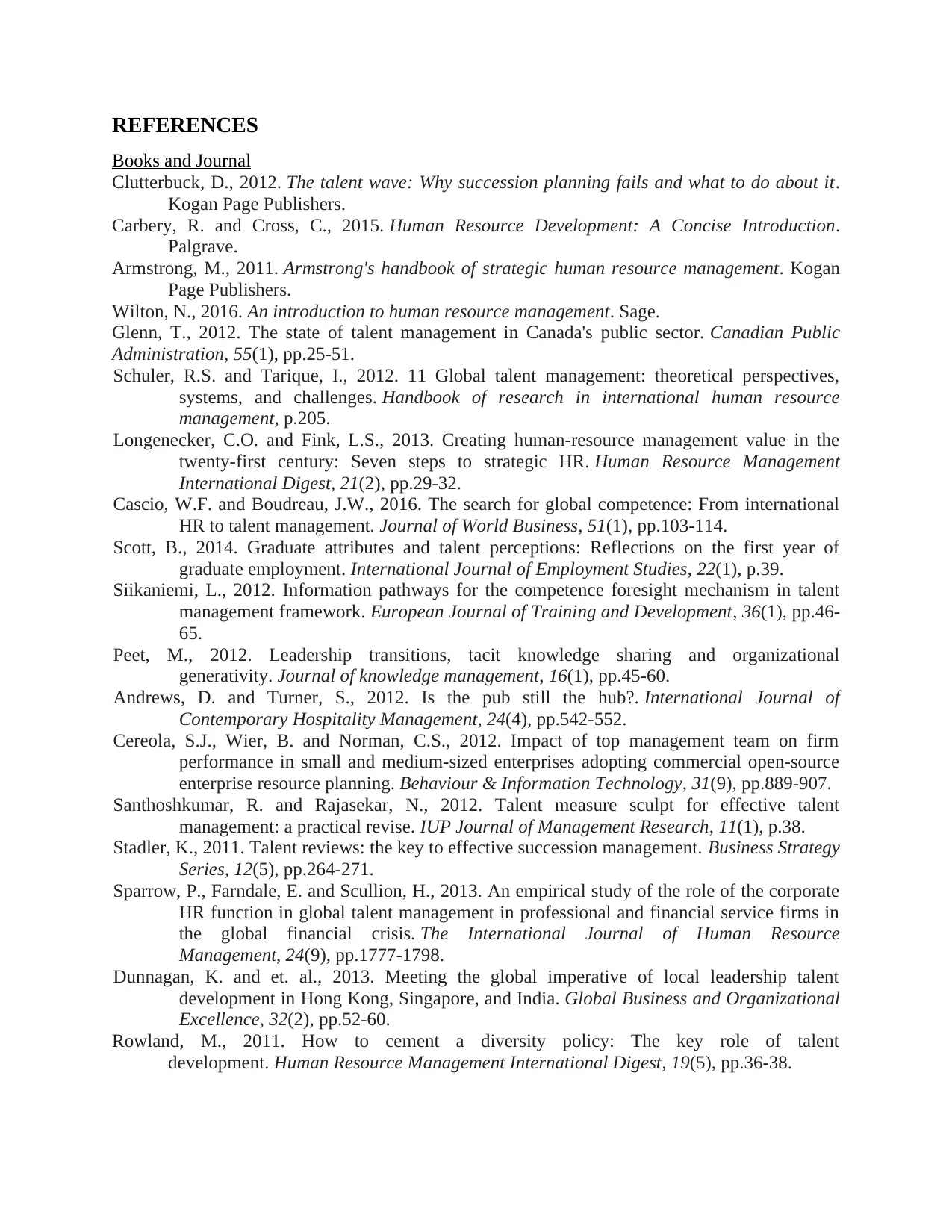
REFERENCES
Books and Journal
Clutterbuck, D., 2012. The talent wave: Why succession planning fails and what to do about it.
Kogan Page Publishers.
Carbery, R. and Cross, C., 2015. Human Resource Development: A Concise Introduction.
Palgrave.
Armstrong, M., 2011. Armstrong's handbook of strategic human resource management. Kogan
Page Publishers.
Wilton, N., 2016. An introduction to human resource management. Sage.
Glenn, T., 2012. The state of talent management in Canada's public sector. Canadian Public
Administration, 55(1), pp.25-51.
Schuler, R.S. and Tarique, I., 2012. 11 Global talent management: theoretical perspectives,
systems, and challenges. Handbook of research in international human resource
management, p.205.
Longenecker, C.O. and Fink, L.S., 2013. Creating human-resource management value in the
twenty-first century: Seven steps to strategic HR. Human Resource Management
International Digest, 21(2), pp.29-32.
Cascio, W.F. and Boudreau, J.W., 2016. The search for global competence: From international
HR to talent management. Journal of World Business, 51(1), pp.103-114.
Scott, B., 2014. Graduate attributes and talent perceptions: Reflections on the first year of
graduate employment. International Journal of Employment Studies, 22(1), p.39.
Siikaniemi, L., 2012. Information pathways for the competence foresight mechanism in talent
management framework. European Journal of Training and Development, 36(1), pp.46-
65.
Peet, M., 2012. Leadership transitions, tacit knowledge sharing and organizational
generativity. Journal of knowledge management, 16(1), pp.45-60.
Andrews, D. and Turner, S., 2012. Is the pub still the hub?. International Journal of
Contemporary Hospitality Management, 24(4), pp.542-552.
Cereola, S.J., Wier, B. and Norman, C.S., 2012. Impact of top management team on firm
performance in small and medium-sized enterprises adopting commercial open-source
enterprise resource planning. Behaviour & Information Technology, 31(9), pp.889-907.
Santhoshkumar, R. and Rajasekar, N., 2012. Talent measure sculpt for effective talent
management: a practical revise. IUP Journal of Management Research, 11(1), p.38.
Stadler, K., 2011. Talent reviews: the key to effective succession management. Business Strategy
Series, 12(5), pp.264-271.
Sparrow, P., Farndale, E. and Scullion, H., 2013. An empirical study of the role of the corporate
HR function in global talent management in professional and financial service firms in
the global financial crisis. The International Journal of Human Resource
Management, 24(9), pp.1777-1798.
Dunnagan, K. and et. al., 2013. Meeting the global imperative of local leadership talent
development in Hong Kong, Singapore, and India. Global Business and Organizational
Excellence, 32(2), pp.52-60.
Rowland, M., 2011. How to cement a diversity policy: The key role of talent
development. Human Resource Management International Digest, 19(5), pp.36-38.
Books and Journal
Clutterbuck, D., 2012. The talent wave: Why succession planning fails and what to do about it.
Kogan Page Publishers.
Carbery, R. and Cross, C., 2015. Human Resource Development: A Concise Introduction.
Palgrave.
Armstrong, M., 2011. Armstrong's handbook of strategic human resource management. Kogan
Page Publishers.
Wilton, N., 2016. An introduction to human resource management. Sage.
Glenn, T., 2012. The state of talent management in Canada's public sector. Canadian Public
Administration, 55(1), pp.25-51.
Schuler, R.S. and Tarique, I., 2012. 11 Global talent management: theoretical perspectives,
systems, and challenges. Handbook of research in international human resource
management, p.205.
Longenecker, C.O. and Fink, L.S., 2013. Creating human-resource management value in the
twenty-first century: Seven steps to strategic HR. Human Resource Management
International Digest, 21(2), pp.29-32.
Cascio, W.F. and Boudreau, J.W., 2016. The search for global competence: From international
HR to talent management. Journal of World Business, 51(1), pp.103-114.
Scott, B., 2014. Graduate attributes and talent perceptions: Reflections on the first year of
graduate employment. International Journal of Employment Studies, 22(1), p.39.
Siikaniemi, L., 2012. Information pathways for the competence foresight mechanism in talent
management framework. European Journal of Training and Development, 36(1), pp.46-
65.
Peet, M., 2012. Leadership transitions, tacit knowledge sharing and organizational
generativity. Journal of knowledge management, 16(1), pp.45-60.
Andrews, D. and Turner, S., 2012. Is the pub still the hub?. International Journal of
Contemporary Hospitality Management, 24(4), pp.542-552.
Cereola, S.J., Wier, B. and Norman, C.S., 2012. Impact of top management team on firm
performance in small and medium-sized enterprises adopting commercial open-source
enterprise resource planning. Behaviour & Information Technology, 31(9), pp.889-907.
Santhoshkumar, R. and Rajasekar, N., 2012. Talent measure sculpt for effective talent
management: a practical revise. IUP Journal of Management Research, 11(1), p.38.
Stadler, K., 2011. Talent reviews: the key to effective succession management. Business Strategy
Series, 12(5), pp.264-271.
Sparrow, P., Farndale, E. and Scullion, H., 2013. An empirical study of the role of the corporate
HR function in global talent management in professional and financial service firms in
the global financial crisis. The International Journal of Human Resource
Management, 24(9), pp.1777-1798.
Dunnagan, K. and et. al., 2013. Meeting the global imperative of local leadership talent
development in Hong Kong, Singapore, and India. Global Business and Organizational
Excellence, 32(2), pp.52-60.
Rowland, M., 2011. How to cement a diversity policy: The key role of talent
development. Human Resource Management International Digest, 19(5), pp.36-38.
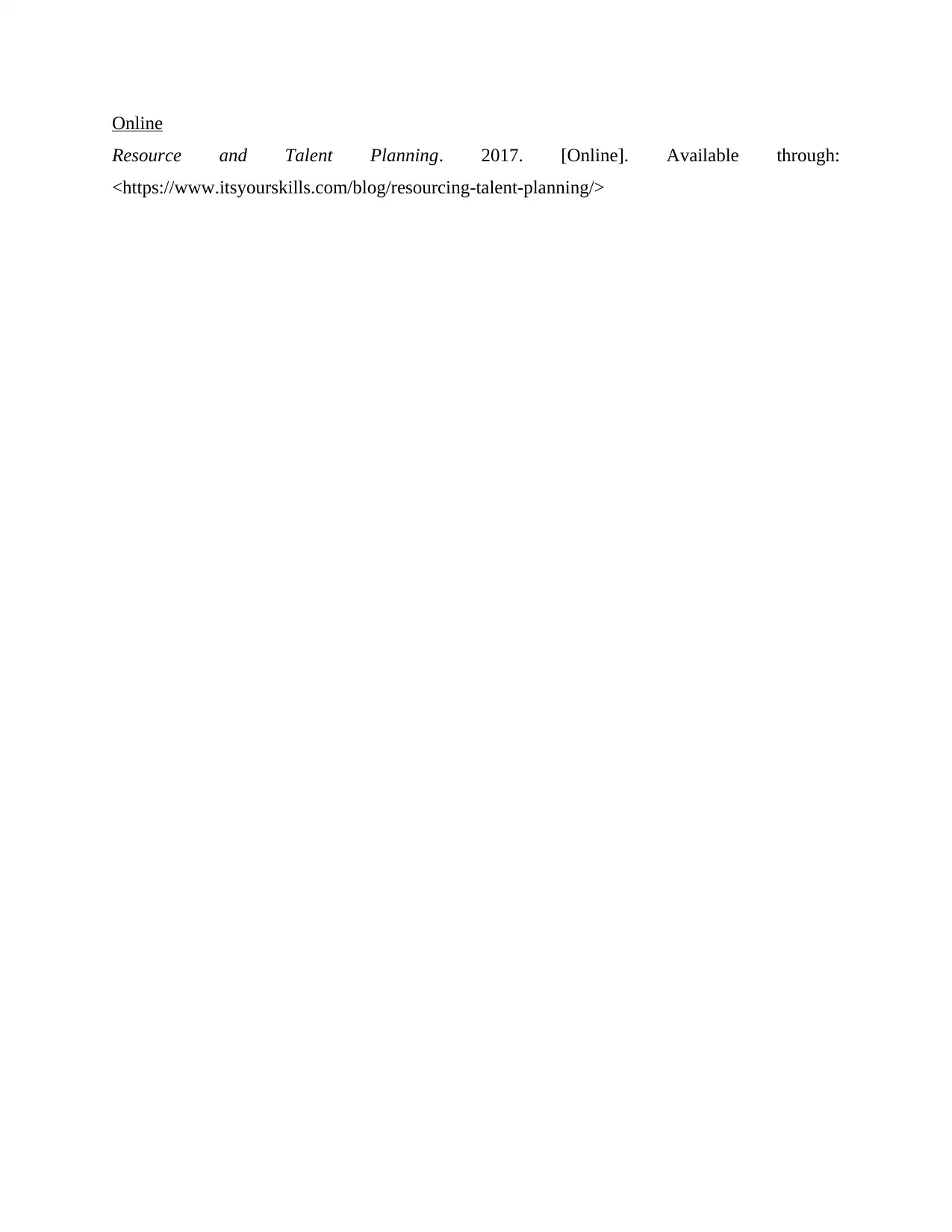
Online
Resource and Talent Planning. 2017. [Online]. Available through:
<https://www.itsyourskills.com/blog/resourcing-talent-planning/>
Resource and Talent Planning. 2017. [Online]. Available through:
<https://www.itsyourskills.com/blog/resourcing-talent-planning/>
1 out of 13
Related Documents
Your All-in-One AI-Powered Toolkit for Academic Success.
+13062052269
info@desklib.com
Available 24*7 on WhatsApp / Email
![[object Object]](/_next/static/media/star-bottom.7253800d.svg)
Unlock your academic potential
© 2024 | Zucol Services PVT LTD | All rights reserved.





